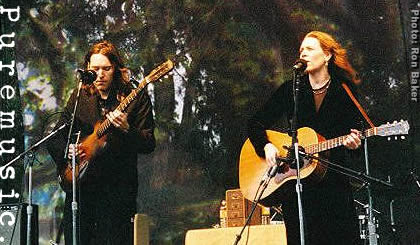
The Ghostly Ones (continued)
Welch is tall and slender. She has a long, narrow face, high cheekbones, wide-set eyes, a sharp chin, and a toothy smile. She is thirty-six. Her skin is pale, and her hair is fine and reddish-brown. Her carriage is upright, and her movements are unhurried and graceful--her shoulders swing slightly as she walks. She collects hymnals, and handmade shoeshine kits, the kind from which people once made a living on the street. She is inclined toward practicality. As a child, she played the piano and the drums but gave them up because she didn't like being confined to whatever room the instruments were in. Onstage, during instrumental passages, she bends her head over her guitar, like a figure in a religious painting, and plays with a ruthless rhythmic precision. There is a sense of self-possession about her that seems more a matter of temperament than influence. Welch is adopted. Her mother, Mitzie, who is a singer, says she is surprised that Welch became a performer, because performers, in her experience, always have a need to please, and her daughter doesn't seem to.
Rawlings is tall and lanky. He has an oval face, a high forehead, dark hair, a long nose, and dark eyes. His hands are delicate. His manner in conversation varies between an austerity which gives him the air of a Pilgrim and a discursiveness in which he never seems satisfied with something he has said--any observation can always be delivered more emphatically or seen from another point of view or elaborated or clarified or even made more concisely. Because his mind is capacious and lively, his talk is nearly always diverting, but he wishes he were less garrulous. He says almost nothing onstage. He plays with his eyes closed and an impassive expression on his face. He stands on his toes and sways, all of which helps cultivate what Welch affectionately describes as "the Dave Rawlings mystique." One day after Rawlings and I had spent the afternoon listening to tapes of bands he had played in and of Welch's earlier work, and I had filled pages in my notebook with his remarks, he slumped in his chair. "I talk so much," he said ruefully. "I am more as I'd like to be when I'm very sick."
Welch and Rawlings's music is deceptively complex, despite its simple components: two voices, two guitars, and four hands. The broadest category into which it comfortably fits is country music. In the Country Music Hall of Fame, in Nashville, a video of Welch and Rawlings performing is shown with other videos that are intended to convey the breadth of modern country music. Welch and Rawlings are portrayed as defenders of a faith--old-time string musicians--practitioners of a lapsed form. They initially found a model for their enthusiasms in records made in the thirties and forties by musicians such as Bill and Earl Bolick, who performed as the Blue Sky Boys. Vocal duets unaccompanied by other musicians were eclipsed in the forties by the more forceful sound of bluegrass--the Blue Sky Boys broke up in 1951--leaving duets as one of the few forms of American music not yet completely covered with footprints. The music Welch and Rawlings play contains pronounced elements of old-time music, string-band music, bluegrass, and early country music, but Welch and Rawlings diverge from historical models by playing songs that are meticulously arranged and that include influences from rhythm and blues, rockabilly, rock and roll, gospel, folk, jazz, punk, and grunge. Furthermore, Welch prefers tempos that are languid. A typical Welch song has the tempo of a slow heartbeat.
Welch's narratives tend to be accounts of resignation, misfortune, or torment. Her characters include itinerant laborers, solitary wanderers, misfits, poor people plagued at every turn by trouble, repentant figures, outlaws, criminals, soldiers, a moonshiner, a farm girl, a reckless beauty queen, a love-wrecked woman, a drug addict, and a child. Her imagination is sympathetic to outcasts who appeal for help to God despite knowing from experience that there isn't likely to be any. Their theology is ardent and literal. They are given to picturing themselves meeting their families in Heaven, where mysteries too deep to comprehend will finally be explained. "Until we've all gone to Jesus / We can only wonder why," she sings in "Annabelle," a song about a sharecropper who hopes to give his daughter more than he had but who delivers her to the cemetery instead. A number of Welch's songs are written from the point of view of male characters. "My Morphine," the drowsy, intoxicated lament of a man whose addiction is souring, is the only song I am aware of about a narcotic which creates the sensation of having taken the narcotic. She is accomplished at compressing dramatic events into a few verses and a chorus. In "Caleb Meyer," a man appears, transgresses, dies, and is revived as a spectre in the imagination of the woman who slit his throat in self-defense. Welch admires the troubadour songwriters Chuck Berry, Bob Dylan, and Hank Williams, and she writes good car songs. The first song she made big money from was "455 Rocket," which was a hit for Kathy Mattea in 1997, and is about a hot rod. continue
print (pdf) listen to clips puremusic home